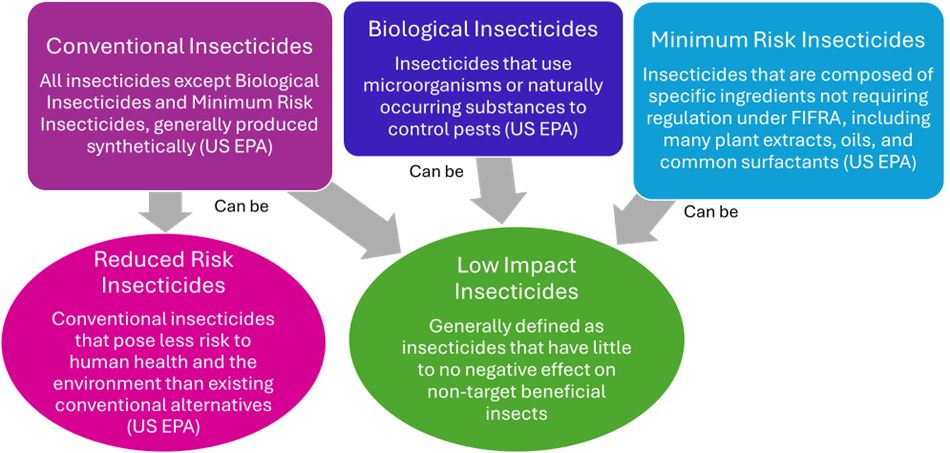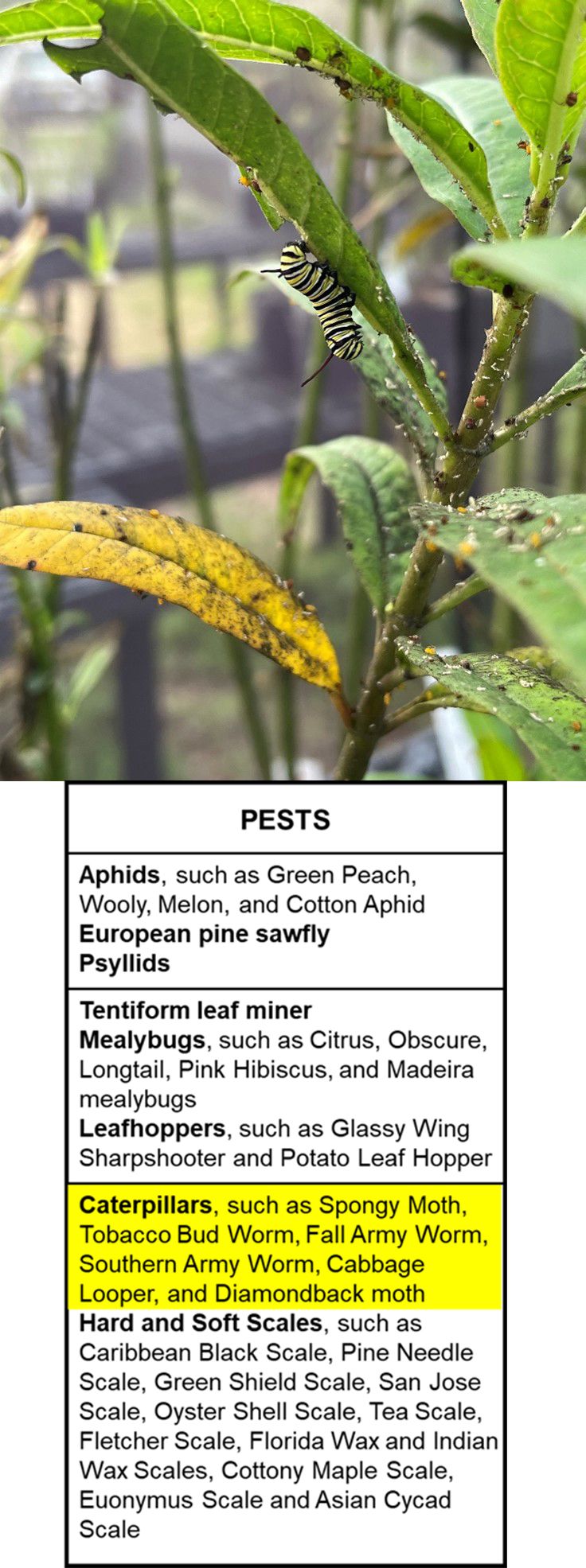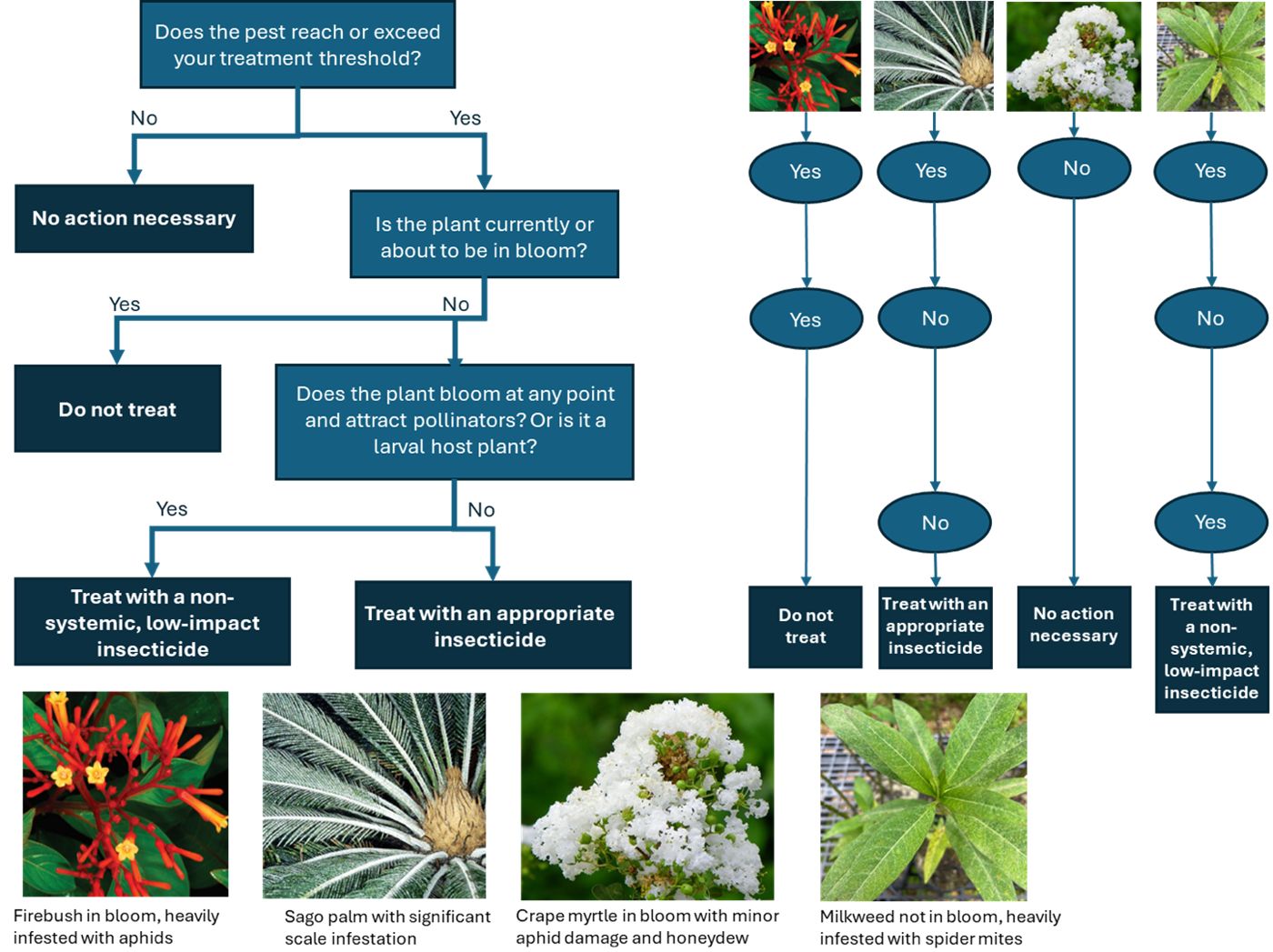This publication outlines key characteristics of insecticides and how their use can conflict with conservation efforts. It suggests several alternative methods for pest control and offers an example flowchart for decision-making purposes. Its intended audience is the public, landscape professionals, and other green industry professionals interested in conserving insects while also suppressing insect pests in their landscapes.
Introduction
Nationwide, more and more people are eager to attract and support beneficial insects and other wildlife in their yards and gardens. This trend is driven in part by increasing awareness of biodiversity declines in insects and the critical role they play in the environment (Kachatryan and Rihn 2021). Research has shown that urban landscapes can support diverse wildlife if managed appropriately (Baldock et al. 2015; Somme et al. 2016; Hall et al. 2017) and that many people are willing to change their landscape management behaviors to support insect conservation (Kachatryan and Rihn 2021). Efforts like the Monarch Waystation Project and the Million Pollinator Garden Challenge, among others, have made great strides to encourage planting diverse plants to attract pollinators and other beneficial insects. Meanwhile, the green industry has made efforts to tailor plant production practices and align marketing with consumer conservation goals.

Adam Dale, UF/IFAS
Despite the best intentions, backyard conservation efforts can be hindered by key insect pest outbreaks and the subsequent use of insecticides. In urban landscapes, pest outbreaks are often more frequent and severe than in rural or natural areas due to a myriad of environmental constraints and stressors such as water or heat stress, poor soil quality, lack of appropriate nutrients, and limited plant diversity, among others (Raupp et al. 2010; Dale and Frank 2018). In other cases, increasingly common invasive species (e.g., chilli thrips, Thrips parvispinus, phantasma scale, and many others) may thrive unchecked, threatening natural ecosystems and thus requiring pest management intervention to mitigate damaging infestations. Consequently, those wishing to attract and support diverse insects may face difficult pest management decisions when trying to balance conservation goals with pest management and plant health needs.
Pesticide Selection and Use
A primary conflict between conservation and conventional pest management is the use of insecticides that are broadly toxic to many insect taxa. This can be a selling point for insecticide products, since it is convenient to have one product that effectively manages a wide variety of pests. However, this broad toxicity can also harm beneficial insects, such as butterflies, bees, and ladybeetles, that feed or reside on the same plant (Krischik et al. 2015; Frank and Tooker 2020; Mach et al. 2024). Even some products that provide improved safety for non-target organisms via reduced exposure, like systemic insecticides, can prove dangerous for beneficial insects that feed on a treated plant’s flower pollen and nectar or leaves, stems, and roots.
The US Environmental Protection Agency has defined several categories and sub-categories of insecticides to help in the pesticide selection process. The three main categories of insecticides are 1) conventional insecticides, which use synthetic active ingredients that are not considered biological insecticides or minimum risk ingredients; 2) biological insecticides, which use microorganisms or naturally occurring substances to control pests; and 3) minimum risk insecticides, which use specific ingredients not requiring regulation under theFIFRA), including many plant extracts, oils, and common surfactants.
Some conventional insecticides qualify as conventional reduced risk insecticides (or simply “reduced risk insecticides”). These conventional insecticides qualify as “reduced risk” because they pose less risk to human health, non-target organisms, and the environment than existing conventional alternatives. This means that they are not neurotoxins, carcinogens, reproductive and developmental toxicants, or groundwater contaminants.
Importantly, “reduced risk” is not always in regard to the specific effects of insecticides on beneficial insects like butterflies and bees. Instead, insecticides that have little to no effect on beneficial insects are “low impact.” Some reduced risk insecticides can be low impact, but others are not. Biological insecticides and minimum risk insecticides can also be low impact. When working with insecticides, it is always recommended to read labels carefully to ensure the selected product will perform as expected. To reduce potential harm to beneficial insects, check the label for the specific wording “low impact.”

Credit: Bernadette Mach, UF/IFAS
Even when a product is specifically formulated to be toxic to only one or a few insect taxa, it is important to remember that most insects are not pests, although many are closely related to pests. For example, some caterpillar species are considered pests of turfgrasses and other ornamental plants, whereas many other species, such as monarch butterfly caterpillars or luna moth caterpillars, are prized and of conservation value. Thus, an insecticide that is applied to a plant to control a pest caterpillar species will likely be just as toxic to the non-pest caterpillar species present or feeding on the same plant.
Additionally, some products advertised as selective and toxic to only a few pest insect taxa can still have broader toxicity in non-target insects. For example, both Btg (Bacillus thuringiensis galleriae), a low impact product, and pymetrozine, a reduced risk product, are advertised as selectively toxic to beetles and aphids, respectively (Harrewijn and Kayser 1997; Asano et al. 2003; Phyllom Bioproducts 2024). However, recent studies have shown that both can have non-target toxicity to monarch butterfly larvae (Danaus plexippus, L.) (Redmond et al. 2020; Mach et al. 2024).

Bernadette Mach, UF/IFAS
The Balancing Act
For some residents and landscape managers, the solution to this conflict between insect conservation and pest management is simply to not treat plants with conventional insecticides. For others, conventional insecticides may be an option but with strong safeguards in place to limit their use and minimize potential non-target effects. Both strategies can be viable alternatives to conventional pest management, especially when using Integrated Pest Management (IPM) or Integrated Pest and Pollinator Management (IPPM) principles. Both management practices emphasize understanding what pest species may be encountered and what damage they cause, setting customized treatment thresholds, monitoring for pests, enacting diverse prevention tactics, and treating with insecticides only when justified.
The plant species in a landscape will largely determine the potential pests present along with the beneficial wildlife supported. Some plants, such as crape myrtles, sago palms, boxwoods, and hybrid tea roses are known to have consistent and specific pest problems year after year. Likewise, some plant species provide relatively little conservation value because they are not a host plant to any non-pest insect herbivores, or they do not provide pollinator-attractive flowers. Choosing not to plant these species and opting for less pest-prone species, thus avoiding the pest problems to begin with, can be an ideal way to balance pest management and conservation.
Increasing plant diversity in a landscape can also have downstream effects on pests. For one, natural enemies (e.g., predatory and parasitic organisms) benefit from habitats composed of many plant species and varying heights and forms. Therefore, planting a large variety of less pest-prone plants can help suppress key pests in a landscape. Familiarity with natural enemies and other beneficial insects associated with a given plant or landscape can also help inform the potential consequences of any pest control actions like insecticide use. Talk with your local cooperative Extension agent, master gardener volunteer, or nursery grower for guidance on the pest susceptibility and conservation value of plant species. Additionally, be sure to scout for pests when purchasing new plants to prevent introducing new pests into a landscape. Of course, not everyone has the luxury of choosing every plant that exists in a landscape. In these cases, doing an inventory of the plant species present and researching common pests on those plants is an important step to understanding what pest problems may occur. Then, when and if pests are detected, be sure to remove the infested plant material to prevent buildup of pest populations. Becoming familiar with these key plants and associated key pests is an important first step in any IPM or IPPM program.
The next key to balancing pest management and conservation is understanding the type and severity of pest damage. Oftentimes, pest damage is largely aesthetic or nuisance in nature (e.g., chewed leaves, damaged flowers, honeydew dripping on cars and sidewalks), and not an actual threat to plant health. In these situations, consider whether treatment is necessary, what cultural or mechanical practices can be employed, and if chemical use can wait until the plant’s health is threatened. Scouting for pests early and often is a critical step towards keeping ahead of potential pest infestations and monitoring for severe damage or plant stress.
Should insecticide treatment become necessary, try to choose reduced risk or low impact insecticide options that have little to no persistence in the environment and low toxicity to non-target insects. See the flowchart below for examples of decision-making criteria for pesticide use with several common ornamental plants. When pesticide use is not warranted, always implement other preventive components of IPM or IPPM programs, including regular monitoring for pests and implementing appropriate cultural management practices.

Credit: Firebush, Jaret Daniels, UF/IFAS; Sago palm, Holly Glenn, UF/IFAS; Crape myrtle, Wikimedia Commons, licensed under the Creative Commons Attribution-Share Alike 4.0 International license; Milkweed, Bernadette Mach, UF/IFAS
Key Messages
- Insecticides can hinder insect conservation efforts, especially when used on plants that host beneficial insects like pollinators and non-pest herbivores.
- IPM and IPPM principles like monitoring for pests, promoting biological control, and using insecticides only when necessary to protect plant health are strongly encouraged.
- If insecticide use is warranted, choose an insecticide that is appropriate for the plant and time of year, and consider how beneficial insects that use that plant may be affected.
Visit the UF/IFAS Bookstore for more resources on integrated pest and pollinator management (IPPM) and protecting beneficial biodiversity in ornamental plant systems.
IPPM in North Florida Landscapes brochure
References
Asano, S. I., C. Yamashita, T. Iizuka, et al. 2003. “A Strain of Bacillus thuringiensis Subsp. galleriae Containing a Novel cry8 Gene Highly Toxic to Anomala cuprea (Coleoptera: Scarabaeidae).” Biological Control 28 (2): 191–6. https://doi.org/10.1016/S1049-9644(03)00060-4
Baldock, K. C., M. A. Goddard, D. M. Hicks, et al. 2015. “Where is the UK's pollinator biodiversity? The importance of urban areas for flower-visiting insects.” Proceedings of the Royal Society B Biological Sciences 282:20142849. https://doi.org/10.1098/rspb.2014.2849
Dale, A. G., and S. D. Frank. 2018. “Urban plants and climate drive unique arthropod interactions with unpredictable consequences.” Current Opinion in Insect Science 29:27–33. https://doi.org/10.1016/j.cois.2018.06.001
Frank, S. D., and J. F. Tooker. “Neonicotinoids pose undocumented threats to food webs.” 2020. Proceedings of the National Academy of Sciences 117 (37): 22609–22613. https://doi.org/10.1073/pnas.2017221117
Hall, D. M., G. R. Camilo, R. K. Tonietto, et al. 2017. “The City as a Refuge for Insect Pollinators.” Conservation Biology 31 (1): 24–29. https://doi.org/10.1111/cobi.12840
Harrewijn, P., and H. Kayser. 1997. “Pymetrozine, a Fast‐Acting and Selective Inhibitor of Aphid Feeding. In‐situ Studies with Electronic Monitoring of Feeding Behaviour.” Pesticide Science 49 (2): 130–40. https://doi.org/10.1002/(SICI)1096-9063(199702)49:2<130::AID-PS509>3.0.CO;2-U
Khachatryan, H., and A. Rihn. 2020. “Are Consumers Interested in Ornamental Plants That Benefit Pollinator Insects? FE997 FE997, 10 2016.” EDIS 2016 (8). Gainesville, FL:5. https://doi.org/10.32473/edis-fe997-2016
Krischik, V., M. Rogers, G. Gupta, and A. Varshney. 2015. “Soil-applied imidacloprid translocates to ornamental flowers and reduces survival of adult Coleomegilla aculate, Harmonia axyridis, and Hippodamia convergens lady beetles, and larval Danaus plexippus and Vanessa cardui butterflies.” PLOS ONE 10 (3): e0119133. https://doi.org/10.1371/journal.pone.0119133
Mach, B. M., S. E. Glynn, J. C. Daniels, and A. G. Dale. 2024. “Target and Non-Target Effects of Insecticide Use during Ornamental Milkweed Production.” Environmental Entomology 53 (4): 648–658. https://doi.org/10.1093/ee/nvae056
Phyllom BioProducts 2024. Product Information. www.beetlegone.com/collections/phylloms-products-are-game-changers
Raupp, M. J., P. M. Shrewsbury, and D. A. Herms. 2010. “Ecology of Herbivorous Arthropods in Urban Landscapes.” Annual Review of Entomology 55 (1): 19–38. https://doi.org/10.1146/annurev-ento-112408-085351
Redmond, C. T., L. Wallis, M. Geis, R. C. Williamson, and D. A. Potter. 2020. “Strengths and Limitations of Bacillus thuringiensis galleriae for Managing Japanese Beetle (Popillia japonica) Adults and Grubs with Caveats for Cross‐Order Activity to Monarch Butterfly (Danaus plexippus) Larvae.” Pest Management Science 76 (2): 472–479. https://doi.org/10.1002/ps.5532
Somme, L., L. Moquet, M. Quinet M, et al. 2016. “Food in a row: urban trees offer valuable floral resources to pollinating insects.” Urban Ecosystems 19 (3): 1149–1161. https://doi.org/10.1007/s11252-016-0555-z